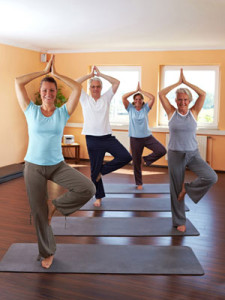
The aging process involves a progressive deterioration of the body including the brain. It actually begins in the late 20s and continues throughout the lifespan. It cannot be stopped or reversed. But, the deterioration can be slowed and to some extent counteracted. This is true for both physical and mental deterioration including degeneration and shrinkage of the nervous system.
Aging healthily to a large extent involves strategies to slow down the deterioration. Meditation has been shown to slow down the deterioration of the nervous system with aging. It acts by increasing the amount of grey matter in the brain through a process referred to as neuroplasticity. Brain areas that are heavily used tend to grow larger while those that are underutilized tend to grow smaller.
In a previous post we described how yoga slowed or reversed age related decline in muscle strength and flexibility (See below). In today’s Research News article “Neuroprotective effects of yoga practice: age-, experience-, and frequency-dependent plasticity”
http://www.ncbi.nlm.nih.gov/pmc/articles/PMC4428135/
Villemure and colleagues demonstrate for the first time that yoga practice also protects the nervous system from deterioration. They showed that with age there was a decline on brain grey matter volume in healthy physically active people, but there was no decline in experienced yoga practitioners.
Interestingly, the more yoga practice the better the protection, the higher the grey matter volume. Yoga consists of postures, breath practice and meditation. It appears that the combination of postures and meditation are the most significant aspects of yoga practice for neuroprotection. It was already known that meditation helped to protect against age related brain deterioration. These results suggest that yoga adds another neuroprotective element in practicing postures.
Yoga practitioners had larger sensory cortex areas than non-practitioners. This is probably because of yoga’s emphasis on paying attention to sensations and visualization techniques used during practice. Also, the largest effects of yoga were seen in the left hemisphere. There is strong evidence that the left hemisphere is responsible for positive emotions. This then suggests that yoga promotes happiness by increasing the size of the left hemisphere. In addition, enlargement was seen in areas responsible for stress management. This provides a potential mechanism for yoga’s ability to relieve stress.
These are exciting findings. The results could provide credence for the long rumored ability of yoga to increase lifespan. They also suggest that the meditative aspects of yoga are very important and that using yoga simply for exercise may be ignoring very important aspect of yoga for the protection of the brain.
So, practice yoga and age healthily.
CMCS
Previous Post
Age Healthily – Yoga
The aging process involves a progressive deterioration of the body. This cannot be stopped or reversed. But, the deterioration can be slowed and to some extent counteracted. This is true for both physical and mental deterioration. But, today’s article, “Age related differences of selected Hatha yoga practices on anthropometric characteristics, muscular strength and flexibility of healthy individuals.”
http://www.ncbi.nlm.nih.gov/pmc/articles/PMC4278134/?report=printable
is focused on the physical deterioration in aging.
As we age we increase body fat and loose muscles mass and strength. The bones become less dense and weaker and thereby more prone to breaking. Cartilage that lines the joints tend to thin leading to arthritis and the ligaments that hold the muscles and joints together tend to harden making us less flexible and prone to injury. Inactivity in aging can exacerbate all of these musculoskeletal changes.
Yoga practice appears to help to slow or reverse these changes. Today’s article demonstrates that the increase in fat mass with aging and the consequent increase in body weight are slowed by daily Hatha yoga practice. The decreased muscle strength as well as the decreased flexibility is also slowed in yoga practitioners. Hence, yoga is an excellent practice for maintaining the individual’s strength, flexibility, and body composition all of which are important for healthy aging.
In addition to the direct benefits there are also a plethora of indirect benefits. The individual looks and feels better. This can lead to improved self-image and even higher levels of activity. These in turn can lead to more frequent and better social interactions. This in addition to the social interactions inherent in group yoga practice. The loss of these social interactions are a major contributor to loneliness and depression in aging. Hence, indirectly, yoga practice can lead to improved social and psychological health.
So, age healthily by practicing yoga!
CMCS




